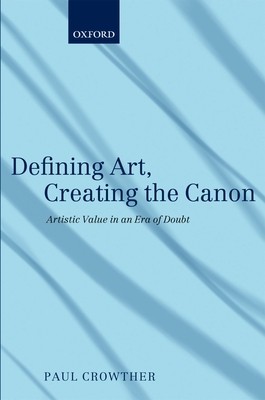
- We will send in 10–14 business days.
- Author: Paul Crowther
- Publisher: Oxford University Press, USA
- ISBN-10: 0199698589
- ISBN-13: 9780199698585
- Format: 15.8 x 23.4 x 1.5 cm, minkšti viršeliai
- Language: English
- SAVE -10% with code: EXTRA
Reviews
Description
What is art; why should we value it; and what allows us to say that one work is better than another?
Traditional answers have emphasized aesthetic form. But this has been challenged by institutional definitions of art and postmodern critique. The idea of distinctively artistic value based on aesthetic criteria is at best doubted, and at worst, rejected. This book, however, champions the traditional notions. It restores the mimetic definition of art on the basis of factors which traditional answers neglect, namely the conceptual link between art's aesthetic value and 'non-exhibited' epistemological and historical relations. These factors converge on an expanded notion of the artistic image (a notion which can even encompass music, abstract art, and some conceptual idioms). The image's style serves to interpret its subject-matter. If this style is original (in comparative historical terms) it can manifest that special kind of aesthetic unity which we call art. Appreciation of this involves a heightened interaction of capacities (such as imagination and understanding) which are basic to knowledge and personal identity. By negotiating these factors, it is possible to define art and its canonic dimensions objectively, and to show that aforementioned sceptical alternatives are incomplete and self-contradictory.EXTRA 10 % discount with code: EXTRA
The promotion ends in 21d.04:18:19
The discount code is valid when purchasing from 10 €. Discounts do not stack.
- Author: Paul Crowther
- Publisher: Oxford University Press, USA
- ISBN-10: 0199698589
- ISBN-13: 9780199698585
- Format: 15.8 x 23.4 x 1.5 cm, minkšti viršeliai
- Language: English English
What is art; why should we value it; and what allows us to say that one work is better than another?
Traditional answers have emphasized aesthetic form. But this has been challenged by institutional definitions of art and postmodern critique. The idea of distinctively artistic value based on aesthetic criteria is at best doubted, and at worst, rejected. This book, however, champions the traditional notions. It restores the mimetic definition of art on the basis of factors which traditional answers neglect, namely the conceptual link between art's aesthetic value and 'non-exhibited' epistemological and historical relations. These factors converge on an expanded notion of the artistic image (a notion which can even encompass music, abstract art, and some conceptual idioms). The image's style serves to interpret its subject-matter. If this style is original (in comparative historical terms) it can manifest that special kind of aesthetic unity which we call art. Appreciation of this involves a heightened interaction of capacities (such as imagination and understanding) which are basic to knowledge and personal identity. By negotiating these factors, it is possible to define art and its canonic dimensions objectively, and to show that aforementioned sceptical alternatives are incomplete and self-contradictory.

Reviews